Nose reshaping is the most common type of service provided by plastic surgeons. Many people still perceive even a small blemish in the nose as a tragedy. But it can be difficult to decide on an operation - rhinoplasty. Modern aesthetic medicine offers an innovative way to eliminate blemishes. In the presence of minor defects, non-surgical rhinoplasty can improve the appearance and make the face symmetrical.
Types of rhinoplasty
In plastic surgery, it is customary to distinguish several types of rhinoplasty according to the technique and the objectives of the surgery.
All types of operations are divided into primary and secondary (repeated) operations, while they can be:
- Reconstructive. This group includes manipulations aimed at restoring anatomical disorders that have arisen due to poor intrauterine development or as a result of injuries or traumatic diseases.
- Aesthetic. Aims to correct the shortcomings.
Depending on the problem to be solved, there are many types of rhinoplasty:
- Reduce. Provides for a reduction in the size of the osteochondral framework of the nose. This can be a shortening of the tip, narrowing of the nasal bridge, the width of the nostrils and lateral cartilage.
- Increase. Intended to correct defects by increasing the size of the nasal skeleton. It is also used for secondary plastics.
- Septorhinoplasty. Elimination of curvature of the nasal septum to facilitate nasal breathing, including to solve the problem of snoring.
- Grafting. The required shape of the nose is created from the cartilage tissue of the patient. For transplantation, the cartilage tissue of the atrium, nasal septum can be removed.
- Reconstructive rhinoplasty. Aims to correct the results of previous operations.
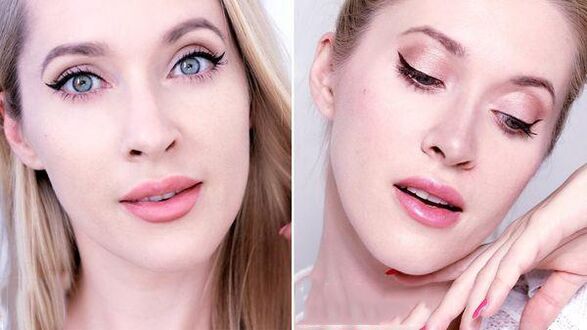
The goal of the intervention can also be a separately enlarged nasal mucosa, the columella (a bridge between the nostrils). Changing the shape of the tip of the nose (eliminating hooks or twists) is a separate and more difficult type of surgery.
For any correction, the surgeon can choose a type of operative or non-surgical intervention.
Operating room
It is performed under general anesthesia. The duration of the operation can be up to several hours, and the result is maintained for many years. Before the operation, the patient must sign a written consent for the surgery. Therefore, it is necessary to carefully weigh the pros and cons and strictly follow the rules of preoperative preparation, which include:
- delivery of blood tests, fluorography, electrocardiogram;
- consultation of doctors of other specialties (dermatologist, therapist, psychiatrist);
- membership in a plan.
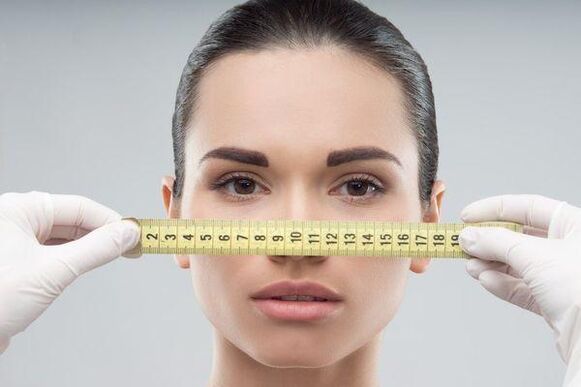
After the operation, the patient is in the hospital for several days under the supervision of medical personnel. After the release, you must also strictly follow certain rules and restrictions.
Like any surgery, reconstructive nose surgery has a number of contraindications and can cause side effects and complications.
Non surgical
Alternatively, plastic without surgery is used. Contour plastic is minimally invasive and does not involve surgery. It allows you to correct asymmetry, slightly reduce the tip, remove the bump, straighten the nose, but is not suitable for solving complex problems (restoring respiratory function, eliminating congenital anomalies).
Differs from classic rhinoplasty:
- the absence of a complex operation and a long period of rehabilitation;
- timeliness;
- short duration of effect (no more than a year);
- the ability to re-run as the result is lost.
This can be plastic injected using fillers, hyaluronic acid-based gels, hormone-disintegrating drugs, or correction without injection using sutures or splints.
Contour rhinoplasty costs several thousand rubles cheaper than traditional rhinoplasty.
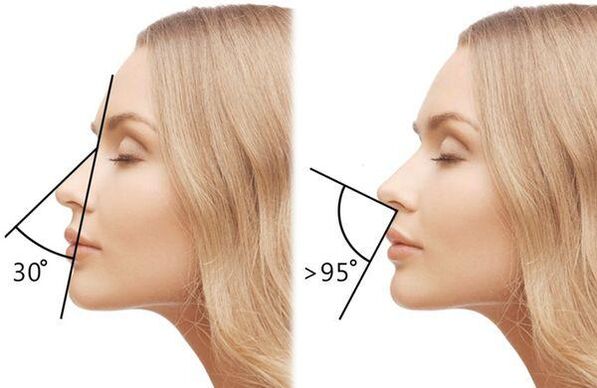
Classifications of operative rhinoplasty
Primary complete rhinoplasty does not involve a procedure that corrects the entire nose. It is the most popular type of surgery. Conditionally, surgical indications are divided into 2 types, according to which the following will be performed:
Cosmetic plastic. If you want to get rid of the following nose defects:
- swelling of the back (bumps);
- excessive length;
- thickened nose (potatoes);
- back saddle;
- large nostrils.
Functional plastic. Intended to eliminate the defects that lead to poor breathing, interfere with the passage of air through the nose:
- an injured septum with a curvature;
- Narrowing of the nostrils (birth defect)
- congenital imperfections of cartilage tissue.
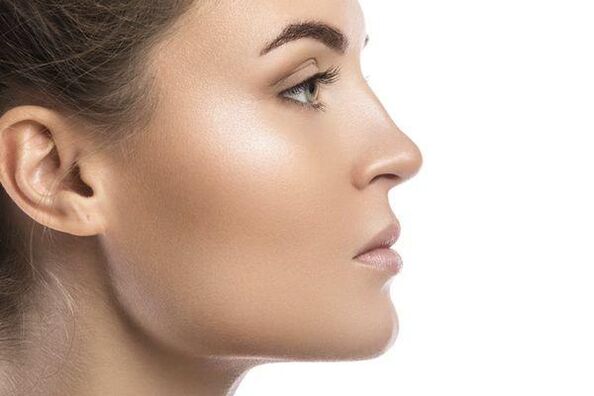
To open
The technique is used in cases where it is not possible to accomplish the assigned task in a closed manner. The incision is made along the columella (the skin part of the fold between the nostrils) and on the wings of the nose where they meet the lip. Open rhinoplasty allows you to lift soft tissue and cartilage upward, to access internal sections for manipulation. Required for technically complex and large-scale operations:
- severe deformation of the nose, including with lateral displacement;
- combination of deformity of the nose with malformations ("cleft lip" or cleft hard palate);
- reconstruction in which grafts are used.
The disadvantages of this procedure include damage to the arteries of the columella, the formation of a postoperative scar, and long-lasting postoperative tissue edema.
Re-rhinoplasty is performed only openly. Correcting the deficiencies of primary plastics is a difficult task, so an uncompromising aesthetic result is not always guaranteed.
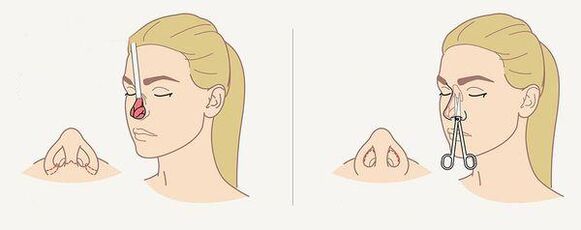
Closed
The method is less traumatic than the open method. The incision is made from the inside, on the mucous membrane of the vestibule of the nose. Such access is performed when a small volume operation is to be performed. This type of intervention is divided into marginal (along the inner surfaces of the wings of the nose), transseptal, inter- and transchondral. One option of closed access is endoscopic rhinoplasty using micro-instruments.
Allows to exclude damage to the arteries and tissue malnutrition, postoperative scars are not visible, since they are located in the nasal cavity, the outside of the skin remains unchanged. The method is often used for cosmetic operations.
Laser
An operation in which a laser is used instead of a scalpel to cut tissue. The laser incision is smoother, since the parallel cauterization of the vessels excludes the development of bleeding.
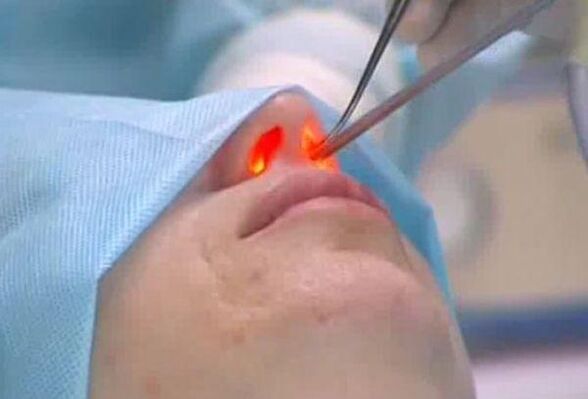
There are 2 types of laser rhinoplasty:
- open, which involves dissection of tissue before shaping the soft part or cartilaginous base;
- superficial - no skin incisions, but the evaporation of the superficial layers to correct small changes in the tissues of the nose.
Reconstructive rhinoplasty by injection
Sometimes those who decide to have rhinoplasty not only want to predict and develop a pattern, but also see the end result. This can be helped by the contour injection nasalplasty procedure. The result is obtained faster, more comfortably and less expensive.
You can inject drugs multiple times. In some cases, fibrous tissue forms at the injection site and the nose can take shape for a long time.
Hyaluronic acid injections
The effect of hyaluronic acid injections lasts about six months. The introduction of drugs allows you to level the surface of the skin and make the nose symmetrical, small irregularities are filled. The fillers based on hyaluronic acid are used in cosmetic surgery. These funds are classified as biodegradable, that is to say dissolving. Over time, the drug breaks down into safe components - water and carbon dioxide.
Plastic nose fillers
There are several groups of loads. Biodegradables, in addition to those mentioned above, include:
- based on animal collagen;
- on collagen of human origin;
- on calcium hydroxyapatite;
- on synthetic lactic acid.
These fillers can have a lasting effect.
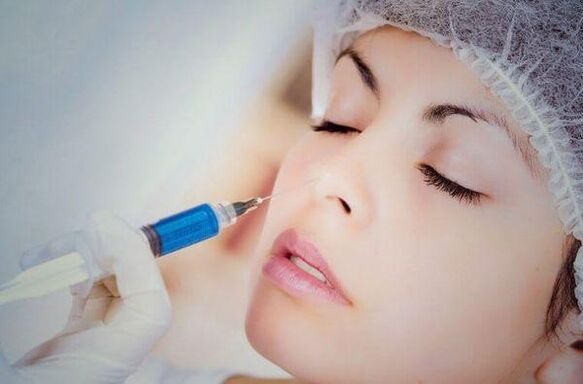
Biodegradable fillers (non-absorbable or permanent) are made from silicone or another synthetic base (biopolymers). The effect after their application persists for a long time, but experts do not recommend using them. There are several reasons for refusing synthetic fillers:
- they can cause tissue fibrosis;
- it is impossible to remove them from the body;
- may in the future become an obstacle to operative rhinoplasty.
Hormonal drugs
To correct certain imperfections of the nose, glucocorticosteroids are used - synthetic substances similar to hormones produced by the human adrenal cortex. They are able to soften and partially dissolve cartilage tissue, which makes it possible to correct the shape of the wings and the tip of the nose, smooth the bump.

The procedure is relatively simple to perform, but difficult to prepare: it is necessary to very precisely calculate the dosage and depth of administration of the drug in order to avoid asymmetry and the formation of unnecessary cavities on the nose. In addition, an excess of hormones can trigger uncontrolled tissue atrophy.
Most often, such a correction is carried out during several procedures.
Lipolytics
Lipolytics are agents used for mesoinjections. It is a biologically active material that promotes the burning of subcutaneous fat. Dermaheal is used to correct the shape of the nose. It helps to remove wrinkles and folds, will get rid of the "fleshy" nose. Contains active ingredients: phosphatidylcholine, hyaluronic acid, carotene and others.
Rhinoplasty without injection
Much less often, the correction of the nose is done without injections. Experts believe that these procedures are not effective enough.

With a clip-on tongue
To align the back of the nose with its tip, use a splint - a plastic or plaster device. The design creates constant pressure on cartilage and soft tissues and changes their position over time. With the help of a splint, you can lift the tip, narrow the wings, reduce the length (by lifting the tip), smooth the bump and restore symmetry.
Nowadays, lightweight removable structures in the form of clips or clips are spreading. They should be worn every day for several months.
Son
To eliminate asymmetry, straighten the back, correct the wings and tip of the nose, filament rhinoplasty is used. Correction technology involves inserting strong self-absorbing threads under the skin. Unlike fillers, the nose does not visually widen after inserting the threads. The result lasts 3 years.

The bion threads are made of caprolac and fix the tissues of the nasal area through a multitude of grooves. The threads are inserted through small punctures, then the beautician tightens them and gives the desired shape to the nose area. The result becomes evident after 2-3 days. Other advantages of using threads:
- low invasion;
- painless;
- the use of local anesthesia;
- no complications;
- no swelling or bruising.
Disadvantages of this method of correction:
- scars may appear at the puncture sites;
- the wires can be profiled, that is to say they will be visible.
The procedure is contraindicated for people with thin, fair skin and those who tend to form keloid scars.
Indications for the procedure
When the shape and size of the patient's nose is satisfied, the doctor will likely prescribe a procedure without performing any surgical manipulations. You can do without a scalpel when correcting details in order to get rid of:
- asymmetry of the nose;
- bumps, dips, depressions and irregularities;
- from the drooping tip of the nose;
- bump;
- from a flat back;
- loose skin near the nose.
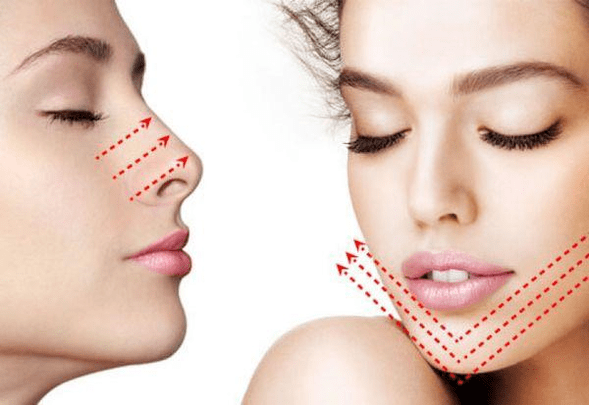
Such a procedure is also used as a temporary measure in the event that a minor patient with a severe disability (as a result of a fracture or injury) cannot be operated on.
At men's
Men prefer a radical approach to modeling with fillers in order to get rid of flaws once and for all. The indications for rhinoplasty in men can be:
- frequent sinusitis, chronic nasal congestion;
- injuries resulting in deformity of the nose and its septum;
- congenital pathologies and deformations of the bone structure of the organ;
- saddle-shaped, large nostrils, wide bridge of the nose, great length or thickness of the nose;
- respiratory disorders;
- the presence of an ugly bump.

In women
Any type of intervention can be applied to women. Which one to resort to, the surgeon decides. If small changes need to be made, the cosmetic problem will be solved without the use of a scalpel. Often, the injection method is used the day before the operation, so that a woman can assess how her nose will look in the future.
What can be corrected using this procedure
Correction of the bump
The reduction is achieved by injecting a charge into the curved part. To correct the lump, the gel is injected along the entire length of the nasal back. Most often, absorbable preparations containing hyaluronic acid are used to straighten the nose.
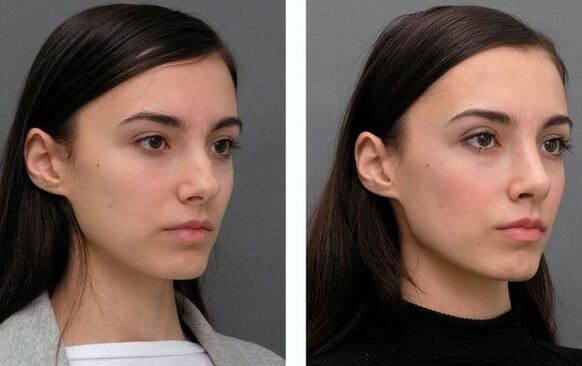
Tip correction
It is carried out by injecting fillers into the problem areas. Such rhinoplasty is particularly in demand when there are small hollows or depressions on the tip of the nose. The potato nose is corrected by introducing a load in the tip, this makes it sharper.
The tip can be lifted by injecting the gel into the columella area of the nose. Visually, this hides the crochet tip. In some cases, it is also necessary to inject into the wings of the nose to narrow the nostrils slightly.
Fix a broken nose
If the nose has been injured more than once, contouring will not help. In such a situation, only nasal septum surgery is indicated. And most likely a full-fledged reconstruction and aesthetic operation. Reconstruction of the septum and the external osteochondral skeleton may be necessary.
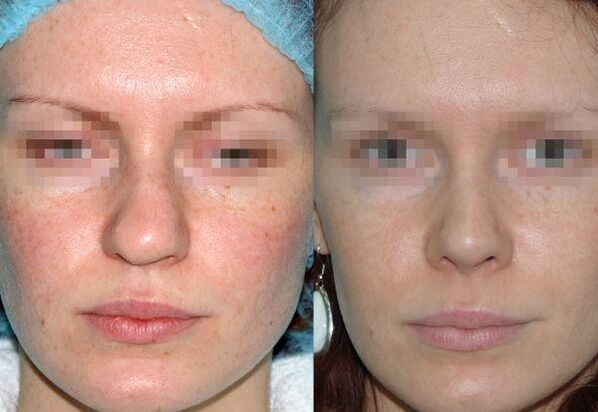
Backrest alignment
It is impossible to align the crooked nasal bridge without surgery. Rhinoplasty by injection only masks the defect. For example, a snub nose correction (with a low bridge and a raised tip) is performed by injecting fillers over the entire surface of the nasal bridge to the tip.
Wing reduction
Hyaluronic acid gel is used to correct the asymmetry of the wings of the nose. In this case, the specialist should accurately calculate the dose.
The nose becomes thinner and more expressive after rhinoplasty with hormones.
If it is necessary to remove or reduce the asymmetry of the nostrils, fillers are injected into the lower part of the wings of the nose.
How old is the operation
There must be clear reasons for the operation on the face. A conscientious plastic surgeon will not undertake the correction of a minor's nose if a certain whim of a girl or boy is the basis.
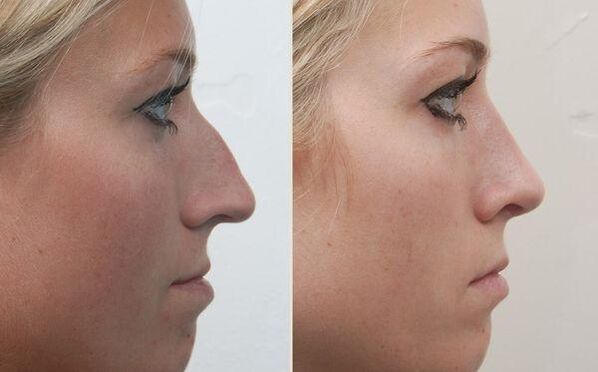
People over the age of 18 are allowed to participate in the operation. In extremely rare situations, this condition can be violated. The minimum age for rhinoplasty for girls is 13 to 14 years old, for boys 15 to 16 years old.
For medical reasons, a teenager can undergo almost any plastic surgery. However, doctors recommend being patient until adulthood, when the organ being operated on is at least 80-90% formed.
How is the preparation for the non-surgical procedure carried out?
Unlike conventional surgery, it is easier to prepare for a non-surgical procedure. Perhaps the doctor will advise you to consult a dermatologist, tell you what tests are done to identify contraindications and restrictions.
Adherence to the following rules will help reduce the risk of complications:
- 10 days before plastic surgery, you need to stop drinking alcohol;
- salicylates increase bleeding, which means that a week before the procedure you must stop taking "Aspirin" and other similar drugs;
- refrain from eating at least 10 hours in advance;
- a few days before the injection of plastics, it is recommended to exclude high physical activity;
- it is necessary to wash your hair the day before, since you can not bend over and wet your face after the procedure.
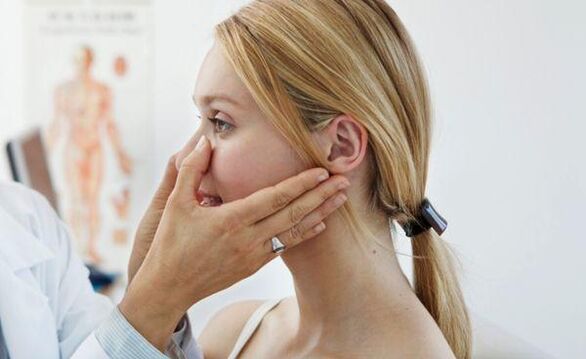
The doctor prescribes the taking of antihistamines. With a high temperature, menstruation, respiratory diseases, the procedure will have to be abandoned until healing.
Do i need anesthesia
General anesthesia is not required for non-surgical rhinoplasty. For anesthesia, local application or infiltration anesthesia is used.
Technology implementation
Non-surgical plastic surgery is performed on an outpatient basis, there is no need for hospitalization of patients. After the procedure, the plastic surgeon's clients go home.
A thorough examination and computer modeling of the future shape of the nose are carried out beforehand. The average duration of the manipulations is 35 to 60 minutes. The operation proceeds step by step as follows:
- The patient is conscious, only local anesthesia is used. The doctor applies a lidocaine-based cream to and around the nose. The exposure time under the film is 10 to 15 minutes.
- After opening the ampoule with the medicine and filling the gel into the microcannula, gradually and carefully inject the filler into the designated areas of the nose. If the client has a desire, he can observe the progress of the process using a mirror, which he will hold alone.
- If necessary, the beautician can reinfuse the putty.
- The last step is a light manual massage. It is necessary for a better distribution of the load.
The result can be evaluated immediately. The fillers are safe and completely absorb in a year and a half.
Consequences and contraindications of non-surgical rhinoplasty
Correction should not be given to women during pregnancy or during menstruation. Nonsurgical correction is contraindicated for people suffering from the following diseases:
- acute infectious diseases;
- keloidosis;
- autoimmune pathologies;
- pathologies of the endocrine system, including diabetes mellitus;
- hemophilia and other blood clotting problems;
- allergies and individual intolerance to the components of the drugs used;
- oncological diseases, tumors of any localization.
What complications can arise
Complications after surgery occur in 10% of cases. They can also occur during surgery (bleeding, skin ruptures, tearing of the mucocartilaginous flap, violation of the integrity of the bone pyramid, fracture of the bone site).
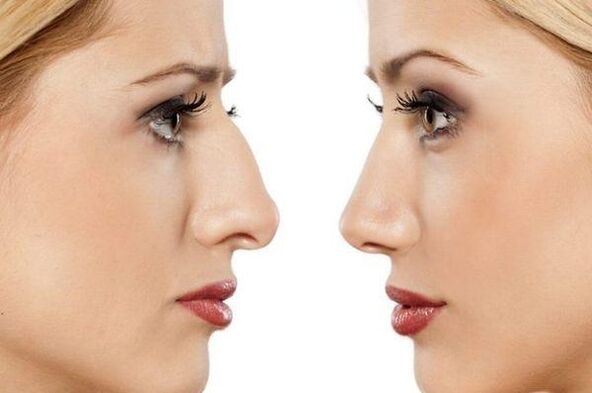
If several cosmetic defects are eliminated during the operation, a number of complications can develop:
- nosebleeds;
- postoperative pigmentation;
- bone calluses;
- soft tissue swelling and hematoma;
- loss of smell;
- the appearance of keloid scars;
- difficulty in breathing;
- curvature of the nasal septum.
Rhinoplasty without surgery is not that dangerous, although it is also considered a difficult procedure in cosmetic surgery. After that, a special splint is applied to the patient's nose, which fixes the result and protects from injury.
For several hours after the procedure, there may be redness and swelling of the skin in the nasal area. These problems go away completely within 24 hours. After tightening with threads, bruises may form, which completely disappear within a week.
Rare complications include those processes that may arise due to the inexperience of the surgeon performing the procedure, or the patient's non-compliance with postoperative rules: displacement of loads and breakage of threads inserted under the skin. The doctor should treat the problem and urgently.
Caring for your nose after surgery
Laser rhinoplasty, hyaluronic acid injections and fillers minimize the rehabilitation period. Immediately after the nose reshaping procedure, you can go home. The swelling goes away within 1 to 2 days.
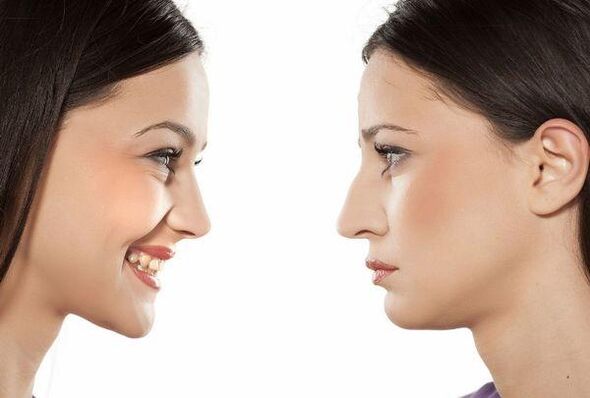
On average, rehabilitation lasts up to several days (depending on the method of correction practiced). There are almost no restrictions after the manipulation is done. You can continue to work, play sports and live your normal life.
In the postoperative period, it is necessary to monitor facial expressions: you can not squint, frown. For several hours, you should not strain your muscles, blow your nose, sneeze and cough. In the first 2-3 days of recovery, you should not wear glasses.
Strict restrictions apply to visiting all bathing places (ponds, swimming pool, public baths, sauna). You should also give up sunbathing, smoking, foundations.
You cannot massage the injection site or perform physiotherapy for 2 weeks.
How long does edema last after surgery?
The entire rehabilitation period after surgery can take about a year. In the first few days, the patient should wear a bandage, bandage or cast. The swelling of the face will go away in 1 to 2 days. After 21 days, the cast is removed and blood clots from the nose and tampons are removed.
Active recovery occurs within 3 months, traces of side effects subside, but minor changes may take place until the end of the year.
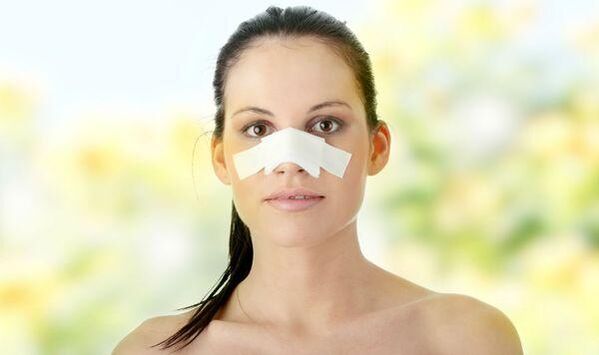
What to do if the operation fails
The result of the operation performed can only be judged after 6 months. Practice shows that 20% of all interventions to correct or eliminate defects in the nose are not the only ones.
If after this time the nose does not take the desired shape or if swelling persists, the operation can be considered a failure. In such situations, repeated operations are assigned.
When to repeat the procedure
The effect of nonsurgical nose surgery lasts about a year on average. You can repeat the procedure at any time.
After surgery, repeated (secondary) rhinoplasty may be prescribed no earlier than one year later. Technically, it is a more complex procedure. It is prescribed if the patient is not satisfied with the result or if the previous operation failed (did not give the expected effect).
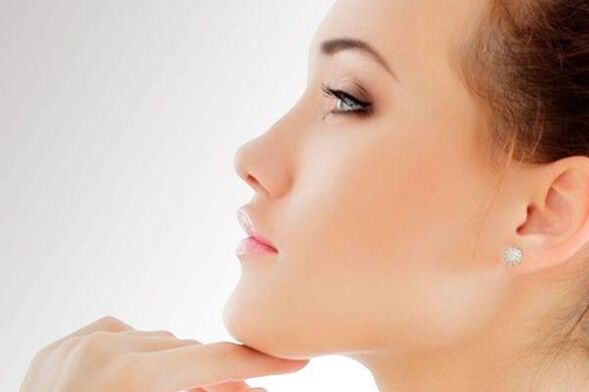
Benefits of non-surgical rhinoplasty
The fill and suture procedure cannot be considered a full-fledged alternative to surgery, but it has a number of clear advantages. The main ones are:
- painless;
- short period of rehabilitation (sometimes absent);
- rapid achievement of results;
- reversibility (you can always return the previous form if the result is not satisfactory).
The procedure has both advantages and disadvantages. It has an extremely weak effect on the general condition of the body, does not injure the tissues of the face, after which scars and scars do not form. But with incorrect injection, gel lumps can form under the skin. Their displacement will cause a change in the shape of the nose.
After a minimally invasive procedure, there are no stitches, the skin heals better. But the risk of infection and infection remains.
The low cost makes the procedure accessible to anyone who wants to improve their appearance. However, possible complications make it necessary to treat the choice of clinic with extreme care.Most often, unsuccessful cosmetic interventions occur after visiting non-specialized salons and doctors who do not have the appropriate qualifications.The final decision should be made only after studying the previous work of the master and the evaluations of the clinic.




















